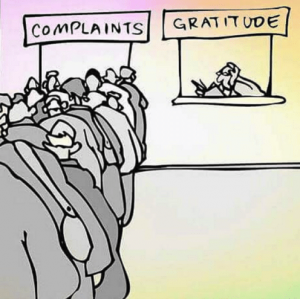Practicing Intentional Gratitude
Learn how we can live fuller, happier lives by thinking critically about our why, who, and how.

Gratitude is interesting because I don’t think it comes naturally to most people. I think it is something that is learned. It can come from your upbringing or community, experiences of hardship, or even witnessing someone else’s hardships, but I believe gratitude is a byproduct of other behaviours.
More than anything, I think that gratitude comes from self-reflection, self-awareness, and approaching life with intention.
I wrote a post called, “How to Happygolf Your Life“. It was a reflection on how my husband managed his cancer diagnosis and treatment and how I handled it. The gist of the concept is that life will throw us curveballs, many of which are completely outside our control, so the only thing we can really control is how we handle it going forward. That is not to say that we are not allowed to be scared or angry or frustrated, or any of the other myriad of emotions that come with life’s challenges. We need to experience those emotions in order to appreciate the alternatives. But I do think we have the power to own those emotions and move past them (sometimes over and over).

It is easy to get lost in fear and uncertainty. It is easy to complain and be annoyed about the inconveniences of the day. It is harder to let go of those feelings and appreciate the people we have in our lives, the privileges many of us experience, and take control of one of the few things we truly can, our attitude. And in turn, our gratitude!
The following are some ways to integrate gratitude into your life through reflection on your experiences and actions you can take to show your gratitude to others.
3 ways to reflect on the things you are grateful for
1. Share your daily dinner table best
One of the things that my brother-in-law and sister-in-law do with their family every night is ask everyone to go around the table and share the best thing that happened that day. It is a nightly habit and the first thing they do once everyone is settled in and getting started on their meal.
These are the ground rules:
- Everyone gets a turn.
- No interrupting.
- No judging someone else’s best.
I know this is not unique to their family, but it is an impactful way to teach children gratitude, and also share your own. Even on a really hard day, the practice gives value to reflecting back to find something good.
I honestly love this. It is a great way to gain perspective and insight into everyone’s day, including your own.
2. Daily refection practice

Identify the 5-8 things (or however many works for you) in your life that are truly important to you. At the end of each day, you reflect back on and record whether or not you put time or energy into any of those items. It isn’t expected that you will do all of the things every day, but after doing this for a while, it is easy to see patterns in the areas you put a lot of energy into and the areas that you aren’t, but need to.
If you record a little about what you did each day, you can look back and really see what you have been doing over the last few weeks.
Gratitude comes in knowing that you took opportunities to invest time and energy into the things that you have identified as important to you, or recognized where you need to refocus.
3. Write a gratitude journal

One of my good friends told me that she keeps a gratitude journal. At the end of each day, she writes in it something she is grateful for. It doesn’t have to be from that day, but it is an ongoing reminder, even when things are hard, that there are always people, things, and experiences in life that are worthy of gratitude and thanks.
The act of writing it down is also an effective way to regulate your emotions and, similar to the daily reflection, is a record that you can look back on when you need perspective.
3 ways to show gratitude
1. Volunteer for organizations that are meaningful to you
For many years I focussed much of my volunteer time and effort on organizations that focus on youth. Junior Achievement, Boys & Girls Clubs Big Brothers Big Sisters (BGCBigs), and Youth Empowerment and Support Services (YESS), to name a few. My role in each of these was very different but they all centred around the idea that investing time and effort in youth is an investment in the future.

More recently I was a board member with Threshold Impact University of Alberta Venture Mentoring Service (TIVMS) and I am currently a mentor on two entrepreneur teams, using my experience as an entrepreneur to support others who are growing their businesses.
Volunteerism is an act of gratitude because it is a recognition of privilege, the overcoming of our own challenges, and our ability to help others.
2. Share your experiences with others through formal or informal mentorship
I have benefited a great deal from the many mentors I have had, and still, have in my life. I have learned a great deal about many different things and, as I have gotten older, I have realized that I know things that are worth sharing. I have skills, experiences, and ways of thinking that can be helpful to others. I share these things through my blog, one-on-one, and in being as open and genuine as I can with the many people I cross paths with.
Everyone has experiences and things of value to share with others, regardless of age or background. The challenge comes in being willing to be open and vulnerable. Sharing those experiences is an act of gratitude in that we get to learn, teach, validate, and commiserate with others so that we all may have an easier path.
3. Verbalize and show gratitude to the people closest to you

We interact with people every day. While driving, at the grocery store, at the office, at a restaurant, etc. Every single interaction is an opportunity to give and show gratitude for the small kindnesses of others. Most people are good at these micro-interactions with strangers, like thanking a server or waving thanks to another driver who let you into their lane.
But when was the last time you thanked your partner for making dinner, doing the laundry, mowing the lawn, or doing the dishes? Or thanked your parents or siblings for watching your kids? Or thanked your best friend for listening to you vent about work? I realize these are day-to-day parts of our lives, chores and expected parts of our relationships…but they are still worthy of appreciation.
I would argue that it is the people that are closest to you that you should show the MOST gratitude to. We get to choose many of the people in our lives and they, in turn, choose us. It is easy to take for granted the people who are closest to us because we often have a flow of life that creates an expectation of what should be done and how we should behave.
Many of the people in our lives are gifts and it is a simple, but powerful thing to tell them regularly how grateful you are to have them in your life and for the little (and big) things that they do.
Summary
We can live fuller, happier lives by thinking critically about why we do things, who we spend our time with, and how we approach our lives, challenges and all. The byproduct of self-reflection and intention is being grateful for the sum of the experiences we have had, the hardships we have overcome, and the people in our lives. We can choose to find ways to build gratitude into our routines and show it by giving our time, effort and thanks to others.
Share
Ashley Janssen

Productivity consultant, writer, speaker, serial entrepreneur, chaos calmer, introvert, cat-lady. Lover of books, fitness, old fashioned’s, basketball, and video games.
Follow me on
Twitter
or
LinkedIn.
Hire me for
1 on 1 productivity consulting
or
speaking.
Related articles

What It Really Means To Be Calm

September Crescendos


Comments ()